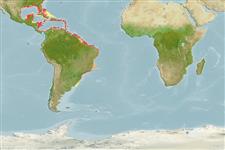Common names from other countries
>
Carangaria/misc (Various families in series Carangaria) >
Centropomidae (Snooks)
Etymology: Centropomus: Greek, kentron = sting + Greek, poma, -atos = cover, operculum (Ref. 45335).
More on author: Bloch.
Environment: milieu / climate zone / depth range / distribution range
Ecologia
marino; acqua dolce; salmastro associati a barriera corallina; amfidromo (Ref. 51243); distribuzione batimetrica ? - 22 m (Ref. 26912). Tropical; 25°C - 31°C (Ref. 36880); 33°N - 35°S, 98°W - 33°W
Western Atlantic: southern Florida (USA), southeastern coast of the Gulf of Mexico, most of the Antilles and Caribbean coast of Central and South America extending southward to Rio de Janeiro, Brazil; also North Carolina and Texas, USA (Ref. 7251).
Length at first maturity / Size / Peso / Age
Maturity: Lm ?, range 42 - ? cm
Max length : 140 cm TL maschio/sesso non determinato; (Ref. 9710); common length : 50.0 cm TL maschio/sesso non determinato; (Ref. 3713); peso massimo pubblicato: 24.3 kg (Ref. 4699); Età massima riportata: 7 anni (Ref. 12193)
Spine dorsali (totale) : 8 - 9; Raggi dorsali molli (totale) : 10; Spine anali: 3; Raggi anali molli: 6. 67- to 72 pored scales on lateral line to base of caudal fin (Ref. 26938). Black lateral line (Ref. 13442).
Adults inhabit coastal waters, estuaries and lagoons, penetrating into freshwater; usually at depths less than 20 m (Ref. 3713). Feed on fishes (Gobiidae, Gerreidae, Engraulidae) and crustaceans (shrimps and crabs) (Ref. 35237). Mature individuals congregate at mouths of passes and rivers during the spawning season, May through September (Ref. 3713). Seasonal movements into freshwater occur but poorly understood (Ref. 3713). Marketed fresh (Ref. 5712). Valued game fish and an excellent food fish (Ref. 26938). The world record for hook and line is a 53-lb., 10 ounce fish caught at Parismina Ranch, Costa Rica (Ref. 13442).
Also Ref. 103751.
Robins, C.R. and G.C. Ray, 1986. A field guide to Atlantic coast fishes of North America. Houghton Mifflin Company, Boston, U.S.A. 354 p. (Ref. 7251)
IUCN Red List Status (Ref. 130435)
Can't connect to MySQL database (fbapp). Errorcode: Too many connections
